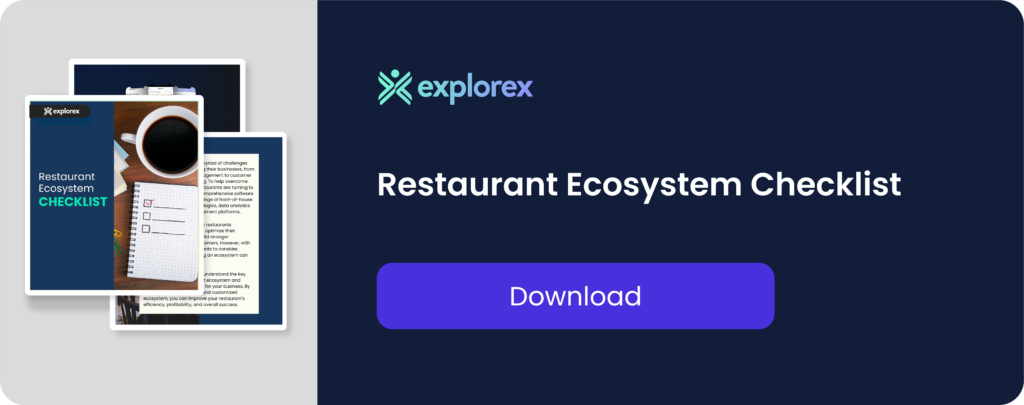The restaurant industry is a highly dynamic and ever-changing landscape that demands constant innovation and adaptation. With so many restaurants vying for customers’ attention, it’s essential to stand out by providing excellent food and top-notch service. Achieving this balance between quality and efficiency can be challenging, especially in a fast-paced environment where every second counts.
Running a restaurant can be a challenging task, and one of the most significant challenges restaurant owners face is streamlining operations. In order to provide a great dining experience, it’s important for restaurants to have efficient processes in place for everything from food prep to serving and clean-up.
However, there are several major problems that restaurant owners face when it comes to streamlining operations, including inefficient workflow, staffing challenges, inventory management, and more. Lately, Many restaurant owners and managers are turning to technology solutions like restaurant management systems to stay ahead of the competition.
For example: La Casa, a brewery, encountered typical issues of managing busy weekends with limited staffing, which led to frequent mistakes and extended waiting periods. To overcome these hurdles, they implemented the Explorex’s Ecosystem Solution system and User Web, enabling their servers to attend to more tables and decreasing their dependence on a larger workforce. Additionally, they resolved difficulties related to payment settlements and night audits, enhancing their accounting process and cash flow in real-time.
The restaurant ecosystem encompasses a broad range of technologies and tools that work together to manage operations, deliver an exceptional guest experience, and drive revenue growth.

Some of the key components of a restaurant ecosystem include:
- Point of Sale (POS) System:
The POS system is the central hub of a restaurant’s operations, enabling servers to take orders, track inventory, and process payments. A modern POS system can also offer features like mobile ordering, tableside payments, and real-time analytics.
- Online Ordering and Delivery Platforms:
As the demand for delivery and takeout continues to soar, restaurants must have a strong online ordering platform to remain competitive. These platforms seamlessly integrate with POS systems, efficiently track orders, and facilitate communication between delivery drivers and the kitchen.
- Inventory Management System:
A good inventory management system allows restaurants to track stock levels, automate ordering, and reduce waste. It can also provide real-time analytics on inventory usage and costs.
- Analytics and Reporting:
Restaurants generate vast amounts of data every day, from sales figures to customer feedback. Analytics and reporting tools help restaurant owners to make sense of this data and use it to optimize operations and drive revenue growth.
- Marketing tools:
Marketing tools can help restaurants to attract new customers and keep existing ones coming back. These tools can be integrated with CRM and POS systems to deliver personalized offers and rewards.
A well-designed restaurant ecosystem integrates front-of-house and back-of-house technologies, data analytics, marketing tools, and customer engagement platforms to deliver an exceptional guest experience, optimize operations, and drive revenue growth which inturn lead to multiple added benefits.

What are the major benefits of a restaurant ecosystem?
By implementing a restaurant ecosystem, restaurant owners and managers can:
- Improve efficiency:
A well-built restaurant ecosystem can help to streamline operations, reduce waste, and optimize the use of resources. This can lead to improved efficiency, lower costs, and higher profitability.
- Enhance customer experience:
By carefully considering the needs and preferences of customers, a restaurant ecosystem can be designed to provide an exceptional dining experience. This can include everything from the decor and ambiance to the menu items and service.
- Communicate and Collaborate Better:
A restaurant ecosystem can facilitate better communication and collaboration between different parts of the restaurant, such as the kitchen and the front-of-house staff. This can help to ensure that everyone is on the same page and working towards a common goal.
- Increase profitability:
By optimizing various aspects of the restaurant ecosystem, such as menu design, pricing strategy, and marketing, a restaurant can increase its profitability and achieve long-term success.
- Create Sustainable practices:
A well-designed restaurant ecosystem can incorporate sustainable practices, such as sourcing ingredients locally, reducing food waste, and implementing energy-efficient technologies. This can help to reduce the restaurant’s environmental impact and appeal to customers who prioritize sustainability.
While restaurant ecosystems can help streamline restaurant operations, restaurant owners often have concerns about their effectiveness.

Here are some common concerns that restaurant owners face and strategies for addressing them:
- Cost:
One of the major concerns for restaurant owners is the cost of implementing and maintaining a restaurant management system. The cost can be particularly prohibitive for small businesses that are already operating on tight budgets. However, there are strategies that can help mitigate the cost of implementing such systems.
Solution:
Restaurant owners should research different systems and compare their pricing plans, features, and support offerings to find a solution that meets their needs and budget. They can also consider cloud-based systems that do not require expensive hardware or software, and offer models that can be more affordable. It’s important to weigh the cost against the benefits that the system can bring, such as increased efficiency, reduced labor costs, and improved customer satisfaction.
- Complexity:
Restaurant management systems can be complex, and not all systems are user-friendly. This can create challenges for restaurant staff who may require extensive training to use the system effectively.
Solution:
To address this concern, restaurant owners should choose systems that are easy to set up and navigate. User-friendly interfaces, clear workflows, and intuitive features can all contribute to a system that is easy to use. It’s also important to ensure that the vendor provides training and support to help staff get up to speed and troubleshoot any issues that may arise.
- Compatibility:
Integrating different technologies and platforms can be challenging, particularly if they were not designed to work together. This can result in inefficiencies and errors that can impact the customer experience.
Solution:
To address this concern, restaurant owners should choose systems that are designed to integrate with other platforms or use APIs to build custom integrations. It’s important to ensure that the systems are compatible with the existing infrastructure and that the integration process is smooth and seamless.
- Data Security:
Restaurants deal with sensitive information like payment details and customer data, so ensuring the security of this data is essential.
Solution:
To address this concern, restaurant owners should look for systems with robust security measures like encryption and two-factor authentication. They should also work with vendors who are compliant with industry standards like PCI DSS, which sets requirements for securing credit card data. It’s also important to ensure that staff are trained in data security best practices and that the system is regularly updated and maintained to prevent security vulnerabilities.
We understand that running a successful restaurant can be a daunting task. However, implementing a restaurant ecosystem can significantly streamline your operations and help you achieve your business goals. With features like inventory management, order tracking, data analytics, and customer engagement platforms, you’ll have everything you need to optimize your business operations and grow your customer base.
If you’re ready to take the next step and explore the benefits of a restaurant ecosystem, we encourage you to do so. Our Explorex team is here to help guide you through the process of selecting the right system for your restaurant and implementing it seamlessly. We’re committed to providing you with a solution that is tailored to your business needs and budget.
Don’t let your restaurant fall behind in this competitive market. Act now and take steps towards implementing a restaurant ecosystem that will help you achieve your business goals. Get in touch with us today at sales@explorex.co learn more about the benefits of a restaurant ecosystem.





